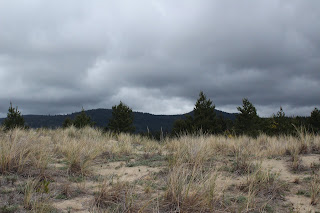It nearly shames me to say I led a hike that was only 5.6 miles long. And on a well-groomed and tame trail, to boot!. I must be getting soft in my dotage, how else to explain this? However, to my few detractors, my snappy comeback retort and rejoinder is "hey, you should have seen me last week!"
 |
| Swingin' Patty of the Dunes |
 |
| See the trail? Me, neither! |
Let's quit reminiscing though, and get back to present tense. On my scouting trip the week before the official hike, the first thing I noticed once I left Alder Dunes Trail, was that the brushy dunes had gotten brushier over the intervening years since my last off-trail sortie. Apparently it was even too brushy for the local fauna, for there was a definite paucity of well-defined game paths through the dunes. However, I did make it to the correct corner of a rectangular-shaped dune, and from there, I entered the forest.
 |
| See the trail? Me neither! |
Several years ago, this was the toughest part of the route and now it was nearly impassable as the sketchy deer path was presently a robust thorny gorse habitat. Amazingly, some intrepid soul had actually sawed through fallen trees and had lopped some of the growth back. Thanks, but I'm not sure how much that helped, it still was tedious and tough going, although Luna (my dog) thought this bushwhacking stuff was more fun than a bucket full of squeaky toys. Why she wasn't all scratched up by the thorns is a mystery, but there certainly wasn't any mystery about my scratched up legs, though. The growth was so dense and thick that even though Luna was leashed a foot or two in front of me, she was nigh invisible in the heavy vegetation.
 |
| Luna, happy to be a dune dog |
Right there and then, I began planning an alternate route to Baker Beach Dunes but where there previously existed a muddy shortcut to the expansive dunes, an impenetrable wall of small trees and large bushes now blocked the way. So onward with my former adventure route it was.
 |
| See the dog? Me, neither! |
After a three-quarter mile wade through standing knee-deep water in thick forest, the sandy dunes between Sutton Creek and the beach came into view. Luna was disappointed all that wading was finished while my boots were glad to be out of the water. Unfortunately, a deep marsh lay between us and the beach so I waded over to a log pile in Sutton Creek and clambered over to the opposite bank while Luna joyfully swam across and back several times.
 |
| Why bushwhacking is hard |
So, the following week, I led all hikers on a wide and well-maintained trail through the coastal forest, hanging my head down in sheepish embarrassment. Not that I particularly care if people get mad at me or not for leading them on a bushwhack/swamp wade, but with visibility being limited as it was by all the thick and scratchy vegetation off-trail, there was a distinct possibility of misplacing a hiker or two on the bushwhack route. Lawsuits can be so expensive.
 |
| Rhododendron graced the forest |
That's OK, though, the easy trail and short nearly six-mile distance allowed all hikers to enjoy a magnificent spring day on the Oregon coast. The sun was out in full blue-skied glory, yet the temperatures were cool and mild in the shaded forest, just perfect for hiking. The spring flowers were putting on a show with tall rhododendrons providing large pink bursts of floral color throughout the forest.
 |
| Vancouver ground cone |
Vancouver ground cone, growing well out of its normal range, was sprouting everywhere underneath salal bushes, providing Professor O'Neill several opportunities to lecture his acolytes on this unique and uncommon saprophyte. Plus, Professor O'Neill took lots of photographs of said saprophyte.
 |
| The campground host led us to this bridge |
We did get somewhat "confused" (not "lost") when our route took us through Sutton Creek Campground but the kind camp host pointed us in the right direction and we resumed hiking on a trail. Ironic, considering we can all navigate dirt trails in our sleep, but get totally flummoxed by a paved road and civilization. Clearly, in a campground and roadway, we were out of our native habitat and comfort zone.
 |
| Yeah, sure, I'll go on the next bushwhack! |
So, although the hike was short and easy, we were able to finish the hike with same number of hikers we started out with. Plus, all hikers returned with the same amount of skin they began the hike with. Double plus, boots stayed dry, although that's not always a top concern of mine. And lest anyone complain about the ease of the hike, well, they can come with me on my next bushwhack adventure.
 |
| Let sleeping snails lie |
For more photos of the two Sutton Creek outings, please visit the Flickr album.
Below, is the bushwhack route. Do not attempt to hike this unless you have routefinding skills and are comfortable navigating in viewless forest. Be sure to take a map and compass!
Below, is the bushwhack route. Do not attempt to hike this unless you have routefinding skills and are comfortable navigating in viewless forest. Be sure to take a map and compass!

























